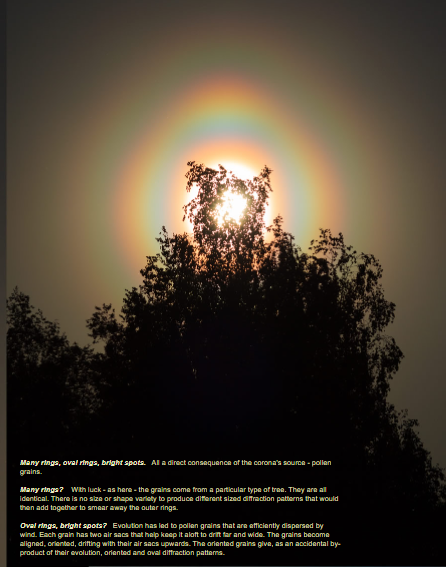OPOD - Pine Pollen Corona
OPOD - Pine Pollen Corona: Exploring the Phenomenon in Detail
Have you ever witnessed a burst of pine pollen that seemed almost synchronized, as if the trees were unloading all they had in one magnificent display? This captivating phenomenon, known as the Pine Pollen Corona, can be a sight to behold. On the 28th of May '13, Jari Luomanen, an avid photographer from Finland, captured an extraordinary example of this natural spectacle. The air was filled with thick clouds of pine pollen as gusts of wind hit the trees, creating a mesmerizing scene.
The Pine Pollen Corona is characterized by many rings, oval rings, and bright spots. These visual elements are a direct result of the source of the corona - pollen grains. When luck is on our side, as seen in Luomanen's photograph, all the pollen grains come from a particular type of tree, making them identical. This uniformity eliminates any size or shape variations that could produce different diffraction patterns, ensuring that the outer rings remain distinct and visible.
Evolution has played a significant role in shaping the characteristics of pollen grains. These grains have evolved to be efficiently dispersed by wind, allowing them to travel far and wide. To aid in their dispersal, each grain possesses two air sacs that help keep it aloft. As these grains drift with their air sacs facing upwards, they become aligned and oriented in a specific direction. This accidental by-product of evolution results in pollen grains producing oriented and oval diffraction patterns, which contribute to the formation of oval rings and bright spots within the Pine Pollen Corona.
It is fascinating to note that each oriented pollen grain produces its own unique oval diffraction pattern. This means that within the Pine Pollen Corona, there are countless diffraction patterns overlapping with one another, creating a complex and intricate visual display. The interplay between these patterns gives rise to the diverse array of rings and bright spots that we observe.
The Pine Pollen Corona phenomenon is a true testament to the wonders of nature. As the pollen grains fill the air, they interact with sunlight, causing the diffraction of light waves. This diffraction leads to the formation of rings and bright spots, captivating our eyes and igniting our curiosity. It serves as a reminder of the intricate connections between living organisms and their environment, showcasing the beauty that can arise from even the smallest and most seemingly insignificant elements of nature.
In conclusion, the Pine Pollen Corona is a breathtaking atmospheric optics phenomenon that occurs when pine trees release an abundance of pollen. The uniformity of the pollen grains allows for distinct rings to form, while their orientation and shape result in oval rings and bright spots within the corona. Each pollen grain produces its own unique diffraction pattern, contributing to the complexity and beauty of the overall display. This natural spectacle serves as a reminder of the intricate interplay between living organisms and their surroundings, reminding us of the awe-inspiring wonders that can be found in the world around us.

Pine Pollen Corona
Jari Luomanen (photography) captured this magnificent example in Finland 28th May '13.
"We had an incredible burst of pine pollen as the trees suddenly seemed to unload all that they had - as if they were synchronized! One could see thick clouds coming off the pines as gusts of wind hit them."
See below for the pollen culprits.
All images ©Jari Luomanen, shown with permission.
Many rings, oval rings, bright spots. All a direct consequence of the corona's source - pollen grains.
Many rings? With luck - as here - the grains come from a particular type of tree. They are all identical. There is no size or shape variety to produce different sized diffraction patterns that would then add together to smear away the outer rings.
Oval rings, bright spots? Evolution has led to pollen grains that are efficiently dispersed by wind. Each grain has two air sacs that help keep it aloft to drift far and wide. The grains become aligned, oriented, drifting with their air sacs upwards. The oriented grains give, as an accidental by-product of their evolution, oriented and oval diffraction patterns.

Each oriented pollen grain produces its own oval diffraction pattern.
Note: this article has been automatically converted from the old site and may not appear as intended. You can find the original article here.
Reference Atmospheric Optics
If you use any of the definitions, information, or data presented on Atmospheric Optics, please copy the link or reference below to properly credit us as the reference source. Thank you!
-
<a href="https://atoptics.co.uk/blog/opod-pine-pollen-corona/">OPOD - Pine Pollen Corona</a>
-
"OPOD - Pine Pollen Corona". Atmospheric Optics. Accessed on November 25, 2024. https://atoptics.co.uk/blog/opod-pine-pollen-corona/.
-
"OPOD - Pine Pollen Corona". Atmospheric Optics, https://atoptics.co.uk/blog/opod-pine-pollen-corona/. Accessed 25 November, 2024
-
OPOD - Pine Pollen Corona. Atmospheric Optics. Retrieved from https://atoptics.co.uk/blog/opod-pine-pollen-corona/.